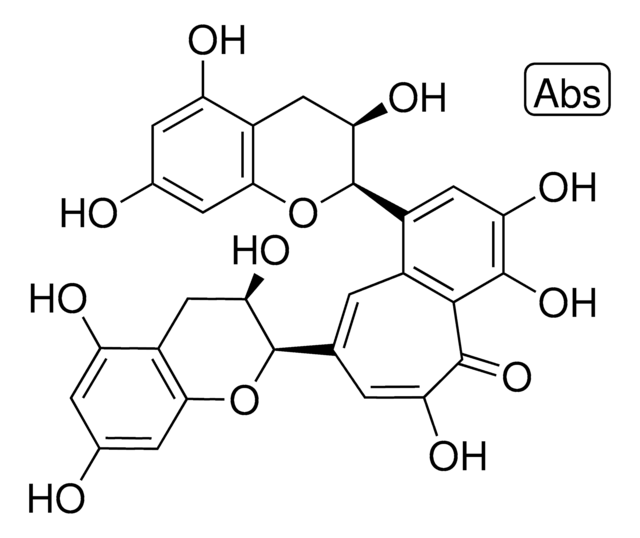53963
Theaflavin monogallate
analytical standard
About This Item
Productos recomendados
grade
analytical standard
Quality Level
description
Mixture of Theaflavin 3-gallate and Theaflavin 3′-gallate
assay
≥80% (HPLC)
technique(s)
HPLC: suitable
gas chromatography (GC): suitable
application(s)
food and beverages
format
neat
storage temp.
−20°C
InChI
1S/C36H28O16/c37-14-5-20(39)18-10-25(44)33(50-28(18)7-14)12-1-16-17(34-26(45)11-19-21(40)6-15(38)8-29(19)51-34)9-27(46)35(30(16)32(48)24(43)2-12)52-36(49)13-3-22(41)31(47)23(42)4-13/h1-9,25-26,33-34,37-42,44-47H,10-11H2,(H,43,48)/t25-,26?,33-,34?/m1/s1
InChI key
CKDOBTPKUHSESZ-MALJIYBWSA-N
General description
Application
Packaging
Storage Class
11 - Combustible Solids
wgk_germany
WGK 3
flash_point_f
Not applicable
flash_point_c
Not applicable
ppe
Eyeshields, Gloves, type N95 (US)
Elija entre una de las versiones más recientes:
Certificados de análisis (COA)
¿No ve la versión correcta?
Si necesita una versión concreta, puede buscar un certificado específico por el número de lote.
¿Ya tiene este producto?
Encuentre la documentación para los productos que ha comprado recientemente en la Biblioteca de documentos.
Active Filters
Nuestro equipo de científicos tiene experiencia en todas las áreas de investigación: Ciencias de la vida, Ciencia de los materiales, Síntesis química, Cromatografía, Analítica y muchas otras.
Póngase en contacto con el Servicio técnico





